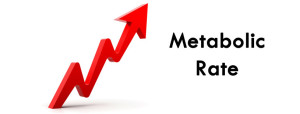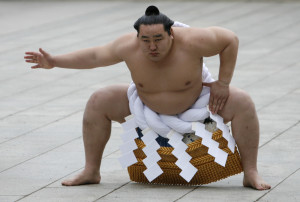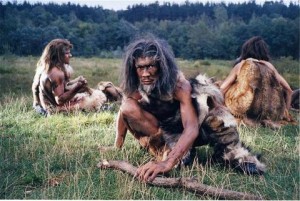Key Points
- The number of calories you burn for every pound of lean body mass is equal to a cherry tomato.
- Teleologically, it makes no sense for RMR to increase to any appreciable extent if one does gain lean body mass.
- Heavy resistance training is great for pretty much everyone. But don’t be hoodwinked by the promise of a jacked up RMR.
By Jose Antonio PhD FNSCA FISSN CSCS – How often have you heard the following refrain? “To increase your resting metabolic rate, you need to lift weights. Putting on muscle is the sure-fire way to have the metabolism of a blue whale.” And that way, the fat will melt off your flabby belly like a stick of  butter on a hot stove. Ok, I put the blue whale part in there. Blue whales can apparently consume half a million calories in one mouthful. Whoa. Can you say Thanksgiving buffet with every bite?! So does making those bi’s, tri’s and glutes a tad bit larger result in resting metabolism that’s copious, capacious or colossal? Or is this Much Ado About Nothing? Before I provide a teleological explanation of why this notion is cockeyed, here’s some food for thought.1, 2 According to Robert R Wolfe PhD, “every 10-kg difference in lean mass translates into a difference in energy expenditure of ~100 kcal/d.” Or in units us Americans prefer, that’s about an increase of 4.5 calories for every pound gained.2 Regardless of whether that number is entirely accurate, let’s just say RMR per unit of fat free mass is about as impressive as dunking a basketball on an 8 foot hoop.
butter on a hot stove. Ok, I put the blue whale part in there. Blue whales can apparently consume half a million calories in one mouthful. Whoa. Can you say Thanksgiving buffet with every bite?! So does making those bi’s, tri’s and glutes a tad bit larger result in resting metabolism that’s copious, capacious or colossal? Or is this Much Ado About Nothing? Before I provide a teleological explanation of why this notion is cockeyed, here’s some food for thought.1, 2 According to Robert R Wolfe PhD, “every 10-kg difference in lean mass translates into a difference in energy expenditure of ~100 kcal/d.” Or in units us Americans prefer, that’s about an increase of 4.5 calories for every pound gained.2 Regardless of whether that number is entirely accurate, let’s just say RMR per unit of fat free mass is about as impressive as dunking a basketball on an 8 foot hoop.
Nonetheless, here’s an investigation that examined resting metabolic rate (RMR) pre and post resistance training. They looked at the effects of 24 weeks of strength training on RMR, energy expenditure of physical activity (EEPA), and body composition. For the purposes of this article, we’ll focus on RMR. They had subjects divided by age and sex: 10 young men (20-30 years), 9 young women (20-30 years), 11 older men (65-75 years) and 10 older women (65-75 years). They performed whole body resistance training 3/week for 24 weeks. Their baseline or pre- and post-training RMR were as follows:
Pre-training
Young men – 12.2 kcal/lb FFM/d
Young women – 13.5 kcal/lb FFM/d
Older men – 12.0 kcal/lb FFM/d
Older women – 13.6 kcal/lb FFM/d
Post-training
Young men – 12.8 kcal/lb FFM/d
Young women – no change
Older men – 12.8 kcal/lb FFM/d
Older women – no change
The first thing that stands out is that in both young and older women, their metabolic rate didn’t change at all. The other thing that stands out is how truly unimpressive the number of calories burned for one pound of fat-free mass (FFM). All groups increased FFM: +4.4 lb in young men, +4.18 lb in young women, +2.2 lb in older men, +1.98 lb in older women. In general, this study suggests that you burn roughly 12-13 kcal per pound of FFM daily. The authors of the study said that changes in absolute and relative RMR in response to heavy resistance training are influenced by sex but not age; that’s good news for us old guys.1
Pratley et al. looked at RMR after 16 weeks of resistance training in 13 healthy 50-65 year olds.3 They found that RMR before and after training was 11.8 kcal/lb FFM/d and 12.3 kcal/lb FFM/d. Interestingly, Broeder et al. found no change in RMR when adjusted for FFM.4
So what gives? Clearly there is quite a bit of variability in the RMR response to gains in FFM. Some folks gain, others nada. Maybe a sex difference exists with men responding better than women. Also, changes in RMR are not solely due to changes in FFM (or skeletal muscle mass). Perhaps it is related to changes in basal sympathetic nervous system tone. Alternatively,

Mongolian-born grand sumo champion Yokozuna Asashoryu wears a ceremonial belly band as he performs a ring-entering ritual at Meiji Shrine in Tokyo January 7, 2008. Asashoryu was banned in August 2007 and fled to his homeland after he outraged fans when he was caught on video playing soccer while supposedly out of action with a back injury. REUTERS/Toru Hanai (JAPAN) – RTX5ATL
changes in organ mass (particularly in very large individuals such as sumo wrestlers) may also account for gains in RMR.5 Have you ever seen the distended guts of professional bodybuilders? That ain’t skeletal muscle. Nonetheless, one might argue that these small changes in RMR could account for significant changes over years and decades. And that certainly may be true. However, it is evident that trifling changes in diet can negate any increase in RMR. For instance, if you gained 5 pounds of lean body mass, that translates roughly into about 50 extra calories per day. That’s not even a mug of beer. Boo.
It makes no sense for RMR to increase significantly even with large gains in skeletal muscle. – One of my favorite college classes as an undergrad was on Evolutionary Biology. The human animal (or heck any animal) has two primary objectives: survival and reproduction. If you can throw in a good sushi buffet, a cruise to the Bahamas, and the Cubs winning the World Series, than even better. Anyhow, getting back to evolution. Let’s take a trip back to the days when there was no running  water or electricity. Man was left to fend for itself like any other wild animal. It helped having a big brain because there was no chance in hell that humans could use physical strength or speed to kill its next meal. Conversely, humans developed quite the endurance capacity to ‘out-work’ its prey and a brain to ‘out-think’ just about every creature on Earth. You’ll notice that even modern day hunter-gatherer societies are ‘endurance’ oriented. You need endurance just to stay alive. Having large muscles serves no survival benefit.
water or electricity. Man was left to fend for itself like any other wild animal. It helped having a big brain because there was no chance in hell that humans could use physical strength or speed to kill its next meal. Conversely, humans developed quite the endurance capacity to ‘out-work’ its prey and a brain to ‘out-think’ just about every creature on Earth. You’ll notice that even modern day hunter-gatherer societies are ‘endurance’ oriented. You need endurance just to stay alive. Having large muscles serves no survival benefit.
Now let’s say some wacky caveman found that lifting big rocks made his chest and arms bigger. Now pretend that for every pound he gained, that would be an extra 50-100 calories per day (urban legend says this figure is true). So a 5 lb gain, which is certainly attainable by even the most average of men, would result in an  increased caloric need of 250-500 calories (according to the urban legend figure). Now where would a caveman get these calories? Would he open the fridge to get a protein shake? Go to Burger King and order a Whopper? Duh. It makes zero evolutionary sense for RMR to go up to any appreciable extent if you gain lean body mass. Or put another way. It is energetically costly to gain and maintain skeletal muscle mass. Why? Because you’d have to feed it you knucklehead. It makes evolutionary sense that it is difficult to gain muscle (which it is) and easy to gain fat (which it is). Why? So you can survive the next go round of the zombie apocalypse when an asteroid the size of Hawaii blasts Earth into a nuclear-winter oblivion. If that happens and you survive, you better pray that you have the genes for putting on fat easily. Otherwise, you and all the Victoria’s Secret models will shrivel to death in a matter of weeks.
increased caloric need of 250-500 calories (according to the urban legend figure). Now where would a caveman get these calories? Would he open the fridge to get a protein shake? Go to Burger King and order a Whopper? Duh. It makes zero evolutionary sense for RMR to go up to any appreciable extent if you gain lean body mass. Or put another way. It is energetically costly to gain and maintain skeletal muscle mass. Why? Because you’d have to feed it you knucklehead. It makes evolutionary sense that it is difficult to gain muscle (which it is) and easy to gain fat (which it is). Why? So you can survive the next go round of the zombie apocalypse when an asteroid the size of Hawaii blasts Earth into a nuclear-winter oblivion. If that happens and you survive, you better pray that you have the genes for putting on fat easily. Otherwise, you and all the Victoria’s Secret models will shrivel to death in a matter of weeks.
Bottom line: Don’t believe the hype when folks say, “a great way to elevate RMR is by increasing skeletal muscle mass via resistance training.” Lifting weights does a lot of great things. In fact, heavy resistance training can help athletes of all kinds (i.e., endurance and strength-power). And yes it does increase muscle mass. But the change in RMR is like pissing in the ocean. And we all know what that’s like. Unless of course you live in Iowa.
About the Author – Jose Antonio earned his PhD at the University of Texas Southwestern Medical Center in Dallas. He completed a post-doctoral research fellowship there as well. His current research focus is on the effects of various ergogenic aids on body composition and performance. He is the CEO of the ISSN and an Associate Professor at Nova Southeastern University.
References
- Lemmer JT, Ivey FM, Ryan AS, et al.: Effect of strength training on resting metabolic rate and physical activity: Age and gender comparisons. Med Sci Sports Exerc 2001, 33:532-41.
- Wolfe RR: The underappreciated role of muscle in health and disease. Am J Clin Nutr 2006, 84:475-82.
- Pratley R, Nicklas B, Rubin M, et al.: Strength training increases resting metabolic rate and norepinephrine levels in healthy 50- to 65-yr-old men. J Appl Physiol (1985) 1994, 76:133-7.
- Broeder CE, Burrhus KA, Svanevik LS, et al.: The effects of either high-intensity resistance or endurance training on resting metabolic rate. Am J Clin Nutr 1992, 55:802-10.
- Midorikawa T, Kondo M, Beekley MD, et al.: High ree in sumo wrestlers attributed to large organ-tissue mass. Med Sci Sports Exerc 2007, 39:688-93.

